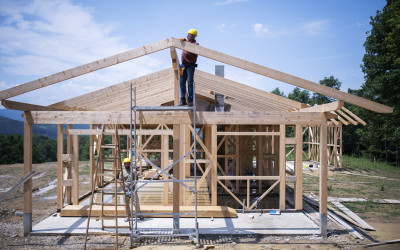Building a custom home is an exciting time. Not only do you get to choose where your house will be located, but you can completely customize the layout and interior. While the journey of building a home on a lot is thrilling and exhilarating, it can also be stressful. There are a lot of factors to take into consideration.
There are ways to prepare for the home building process. New considerations may pop up along the way that results in your need to pivot a certain aspect of your house. You want to make these decisions yourself and not leave it up to your builder. Your custom home should be 100% your vision.
Below are six things you should know before embarking on building a home.
Building a Home on Your Own Lot? Keep These 6 Things in Mind
Designing your home puts you in the driver’s seat. You and your designer work together to include features you want, so long as you stay within your budget. There are some things you should keep top of mind before building your home on a lot.
1. Purchase a Building Approved Lot
The lot you build your home on needs to be an approved building site. You can verify this by heading into your city’s planning office and ask to see their public maps. Once you find your lot on a parcel map, look at the notes about your property. If there are no notes, your lot is likely an approved building site. If there is a note that says that it’s not approved or is subject to being approved, you’ll want to look into that further.
You’ll also want to check into how the lot is zoned and if you can build a home on it. The local zoning regulations will determine what kind of house you can build. Local building codes will also control the construction of your house as well. Hire a state-licensed land surveyor before you buy the lot so they can investigate any potential restrictions.
2. Design Your Home for Your Future
Whether you are single, a young couple, have a few kids running around, or are empty-nesters, think about how you want the floorplan to work for you long term. During the design process, think at least five to 10 years down the line. Custom homes can cost upward of $350,000, depending upon the square footage and features you choose. It is a major investment and not something you want to sell within a few years because the layout no longer works for you.
3. Figure Out Your Budget
Custom construction lets you build a house that meets your design aesthetic and functionality needs, but they aren’t cheap. In addition to the cost of your builder and supplies, you’ll also need to hire a residential architect. The cost can sometimes range from 5% to 15% of the total cost of construction.
You can work with a home building company to help estimate the construction costs. You’ll also need to take into account taxes, down payment funds, and extra money for unexpected expenses. Once you figure out your budget, work with a mortgage broker to determine the type of loan you need, as well as a home mortgage.
4. Research Builders and Contractors
Interview multiple contractors and get quotes. Ask around friends and family for recommendations but look online for reviews first. Oftentimes, your selected builder will have contractors on staff or some they prefer to work with. Once you’ve found a few that look good, interview them and ask for references. Since you’re building a house from the ground up, you want someone who is qualified and can handle the scope of work.
5. Design With Sustainability in Mind
Building a new home allows you to make it energy-efficient and eco-friendly. Save on water by installing low-flow kitchens fixtures and dual flush toilets. If you have the budget, you can install solar panels, micro-hydroelectric generation, or residential wind turbines; the possibilities are endless!
You can also save on energy by installing LED lights, selecting efficient appliances, and using programable thermostats. Research energy-efficient insulation for your home. Spray foam insulation reduces heat loss and seals any potential leaks in your ceiling, floor, and walls.
6. Be Flexible
Unforeseen circumstances arise in homebuilding. Things can take longer than expected, especially if materials are delayed. Even if you have done all your research, hired the best contractor, and have hit every item on your checklist, things can still go awry.
Start Designing Your Custom Home Today
The process of having your home designed and built to your design aesthetics and lifestyle should be exciting. While it may be plagued by stressful moments, preparing yourself and being flexible is essential to ensuring your home is built seamlessly. You don’t have to sacrifice your vision to have your dream home built. Think long-term about how your home can serve you and your family for years to come.
Don’t be afraid to put some sweat equity into your home. You may not be an expert on grouting tiles or painting crown molding, but it is a good way to keep your house on schedule and learn some new skills along the way.
Share this Post
